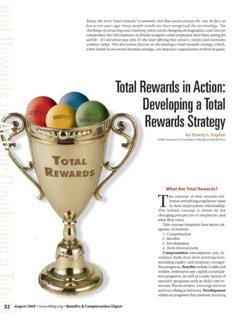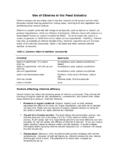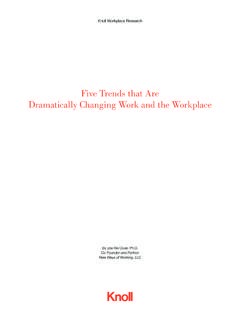Transcription of Business Strategy, People Strategy and Total …
1 Business Strategy , People Strategy and Total Rewards September 2007 Vol. 44, No. 9 by Stacey L. Kaplan 2007 International Foundation of Employee Benefit PlansMany executives are quick to introduce a new compensation or benefit program be-cause they ve heard about it in the news or through one of their colleagues. However,this program may just be the latest plan du jour, not fitting within their organiza-Continued on page 13tion s strategic direction. It is important toidentify and implement programs thatbring an organization further along itsstrategic path. This article strives to connectthe dots among Business Strategy , peoplestrategy and Total rewards. It describes thevalue of integrating these initiatives and thevalue that a Total rewards Strategy brings inthe achievement of Business goals. It pre-sents a how-to approach in linking the Total rewards defined as compensation,benefits, learning and development, andwork environment to an organization sbusiness and People human resources (HR) profes-sionals aspire to forge a strategic part-nership with their top , this expression appears dilutedupon observing HR executives buried in administrivia, focused on operationaltactics rather than Business HR executives to play the esteemedrole of strategic partner, they mustdemonstrate Business knowledge.
2 Thisknowledge includes not only how a for-profit entity earns its money or, in thecase of a nonprofit, how it fulfills its mis-sion, but also how it serves its customersand differentiates itself from its competi-tors. Too often, that knowledge is management will continue to ex-clude even the most experienced HR di-rectors from boardroom discussions untilthey exhibit financial literacy and busi-ness acumen. When HR professionalsdemonstrate their understanding of whatis driving their Business , they will addvalue by mobilizing the right workforcewith the right skills to achieve the busi-ness goals of the the Stage:Understanding Your BusinessThere are many factors influencing theformulation and execution of a soundbusiness Strategy . When thinking aboutstrategy, one must look forward and visu-alize how the organization might Strategy provides the roadmap, ar-ticulating the organization s overall busi-ness direction.
3 What is the mission ofyour organization? A mission statementdescribes its overall purpose what youdo, who you do it for and how you do is your vision? Defining an organi-zation s vision requires forward thinking,since it articulates the organization s de-sired with mission and vision are or-ganizational values that describe what isimportant to your organization and serveas enablers to accomplishing its may be qualitative ( , teamwork,respect) or quantitative ( , dollars). Themission, vision and values provide afoundation for Business Strategy , but thatis just the beginning of the discussion, asevidenced by the agenda of just aboutevery strategic planning session. Execu-tives may labor for hours drafting themost articulate mission and vision state-ments, but this exercise alone will notdrive the organization forward. Othercritical questions must be asked and an-swered relating to customers, competi-tion, culture and the company s positionin its 101 taught us about thetypical Business lifecycle of emergence,growth, maturity and decline.
4 Emergingand growing companies execute theirstrategies differently than mature compa-nies or those in decline. It is important foran organization to understand its currentposition in its lifecycle and determine if itwishes to compete in that position orstrive to change it. For example, bankingtraditionally has been considered a ma-ture industry; however, with other finan-cial services companies offering compet-ing services ( , insurance companies,COMPENSATION September 2007 Benefits & Compensation Digest13 Business Strategy , People StrategyContinued from page 1 Executives may labor for hours drafting the mostarticulate mission and visionstatements, but this exercisealone will not drive theorganization unions), banks have revampedtheir thinking, and some have changedtheir Business Strategy to contend with anew set of organizations face the challengeof managing businesses across multiplelifecycles.
5 Superior Energy Services, aNew Orleans-based provider of special-ized oilfield services and equipment serv-ing the oil and gas industry, encompassesboth mature and emerging businessunits, resulting from several acquisitionsover the past few to Ray Lieber, vice presidentof HR, We re required to tailor our busi-ness and People strategies to our busi-ness units, since our company is com-prised of both growth-oriented andmature Business lines. Although we are agrowth company, some of our businessunits have reached a more mature cycledue to the nature of their services andcurrent geographic operating areas. In their writings about general busi-ness Strategy , Benjamin Tregoe and JohnZimmerman from Kepner-Tregoe, Inc.,identify driving forces that propel or-ganizations to accomplish their goals(see Table I). Although the authors namenine possible driving forces, typicallyonly one or two serve as the basis forbusiness Strategy , determining the typesof products and services offered and themarkets in which they are offered.
6 For ex-ample, financial institutions and automanufacturers are product driven, com-mitted to increasing the quantity andquality of their products. Consumerproducts and retail organizations aredriven by market needs. Organizationsthat are technology driven focus on de-veloping products and services that arebased on the latest technological ad-vances. Production-driven companies fo-cus on maximizing their production ca-pacity, such as hospitals striving to fillbeds and airline carriers aiming to oc-cupy seats. Knowledge of an organiza-tion s key driving forces keeps it focusedon its path to execute its Business companies formulate theirbusiness Strategy , they determine howthey intend to compete in the market-place. Over 20 years ago, marketing guruMichael Porter defined competitive strat-egyas being different and identifiedContinued on next pagethree ways in which an organizationmight compete.
7 These principles are stillvalid today. Will they compete on price,like Wal-Mart ( , be the low-costprovider)? Will they try to differentiatethemselves based on products or ser-vices, like Nike? Will they segment themarket and focus on a particular group ofbuyers or geographic area, like IKEA? Un-derstanding the competition is a businessimperative. HR professionals are aware ofthe competitive landscape from an at-traction and retention standpoint butwould benefit from knowledge of theircompetitive environment at initial step for HR to forge a strate-gic partnership with senior leadership isto participate in open dialogue about theorganization s Business Strategy alongwith its short-term and long-term left is a list of key questions to ask topmanagement to understand its currentand future Business challenges. This is aprecursor to establishing a People strat-egy that defines the resources and capa-bilities required to execute the businessstrategy.
8 The answers to these questionswill provide a framework upon which todevelop a People Strategy aligned withthe Business Your People StrategyOnce the Business Strategy has beendefined, top management and its subordi-nate leaders must execute the businessplan. A solid People Strategy plays a criti-cal role in moving the company forwardin attaining its goals. A People Strategy or HR Strategy defines the resources re-quired to execute the Business Strategy ,including the competencies needed tosupport the objectives of the definition relates to the classic phrase the right People with the right skills. Theleadership team retains its responsibilityto define the requisite behaviors and skillsand to identify and bridge the gaps be-tween the as is workforce and the to be People Strategy with businessstrategy affects how workers are example, Southwest Airlines builds itsbusiness Strategy around low operatingcosts and stellar customer service.
9 Its peo-ple-centric culture enables it to execute itsstrategy. Southwest needs a workforce thatembraces customer friendliness and cus-tomer satisfaction, and the company re-cruits individuals who possess strong com-munications and customer-facing job design, Southwest em-braces broader roles rather than narrowlydefined jobs to create a more flexibleworkforce. The carrier empowers its work-ers to make decisions with considerablefreedom and responsibility. Worker flexi-bility, including the ability to demonstrateskills across multiple job roles, facilitatescustomer events influence an organi-zation s People Strategy and the composi-tion of its workforce. Events such asmergers, acquisitions, staff reductions,plant closures and expansion into othercountries affect the organization s talentrequirements. If a mature organizationacquires an emerging company whosecompetencies lie in innovation and tech-nology, the workforce requirementschange.
10 Leaders must respond by recruit-ing and developing technically savvyworkers and determining how to keepthem engaged and productive. In thecase of global expansion, required skillsets may change to execute the businessstrategy in another country. This mightinclude the need for a bilingual work-force with an understanding of the cul-ture and Business mores abroad. To besuccessful, attraction and retention poli-cies need to be aligned with strategicbusiness Sears, Roebuck and Co. em-barked on a Business transformationabout ten years ago, it aspired to becomea compelling place to work, shop, and in-vest. This slogan demonstrated align-ment with its key stakeholders employ-ees, customers and shareholders. Totranslate its Business goals into reality, thecompany educated its employees at all14 September 2007 Benefits & Compensation DigestDriving Forces and Sample Organizations in AlignmentDriving ForcesSample OrganizationsProducts offeredFinancial servicesProduction capabilityHealth careMarket needsConsumer productsNatural resourcesPetroleumMethod of saleDoor-to-door salesMethod of distributionManufacturer s representativesSize/growthConglomeratesT echnologyScientific innovatorsReturn/profitPortfolio companiesSource:Kepner-Tregoe and International Foundation of Employee ISample Questions to Ask Top Management What are your mission/vision/values?







